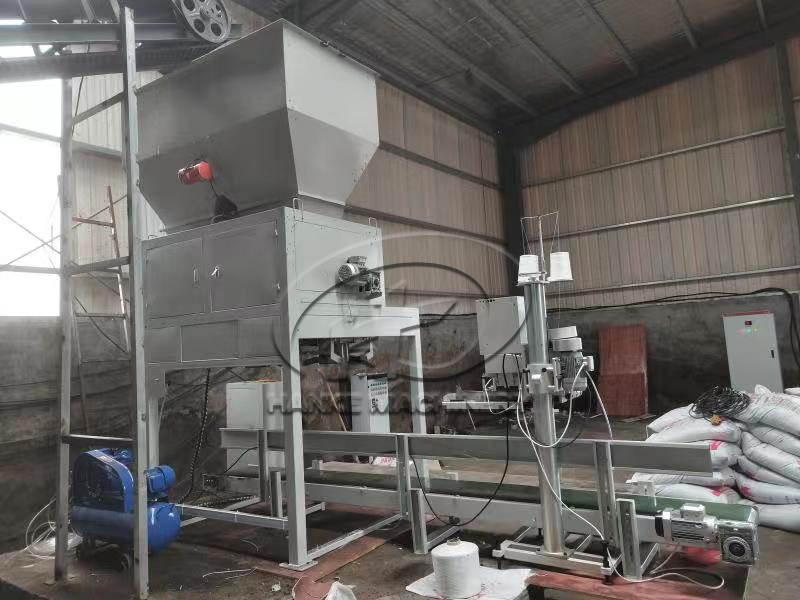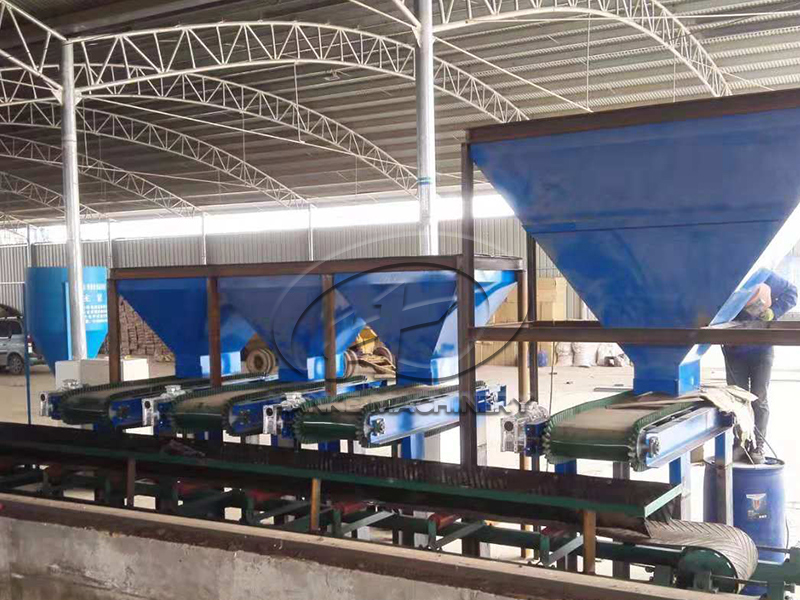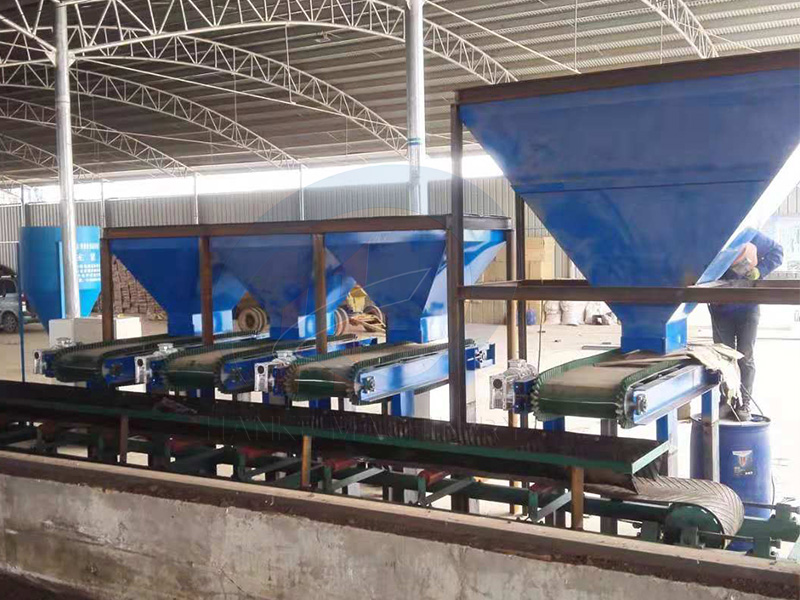 HOME > News > Industry News > How to reduce the maintenance cost of a 20-ton-per-hour granular compound fertilizer packaging machi
HOME > News > Industry News > How to reduce the maintenance cost of a 20-ton-per-hour granular compound fertilizer packaging machi Update time : 2025-09-18 Publisher:Zhengzhou Hanke Machinery
Reducing the maintenance cost of a 20-ton-per-hour granular compound fertilizer packaging machine lies in the principle of "prevention first and scientific management". It requires a multi-dimensional approach, including equipment selection, daily operation, maintenance strategy, and spare parts management. The following methods can be referred to:
1. Source control: Select the right equipment + match the material to reduce inherent wear and tear
Prioritize selecting "wear-resistant" equipment
Granular compound fertilizers may contain trace impurities (such as sand and stones) or have fluctuating moisture content. When selecting equipment, it is necessary to choose wear-resistant and corrosion-resistant components:
Select high-wear-resistant rubber material (such as polyurethane-coated belts) for conveyor belts instead of ordinary canvas belts to extend their service life;
Select stainless steel 304 or wear-resistant cast iron materials for components that come into contact with the material, such as feed wheels and hoppers, to reduce material abrasion;
Select well-known brands for pneumatic components (such as SMC and FESTO) to avoid frequent air leakage and blockage due to poor quality components, which would increase replacement costs.
Pre-treat the material to reduce equipment load
Material characteristics are the key to the lifespan of wear parts. Pre-treatment should be done before entering the packaging machine:
If the fertilizer moisture content is greater than 15%, add a drying or screening process to avoid wet material adhering to the sealing strips and blocking the feed port, which would accelerate the aging of the strips and cause the feed wheels to jam;
Install a pre-removal screen (such as a 1-2mm filter screen) to filter out sand, stones, and lumps, preventing them from wearing the conveyor belt and scratching the weighing sensors.

2. Core measures: Fine-tune daily maintenance to extend the lifespan of wear parts
Daily maintenance is the most cost-effective way to reduce maintenance costs. A clear maintenance process should be established and strictly followed, with a focus on the following components:
Component type | Maintenance points (to reduce wear) | Frequency
Transmission system | 1. Regularly add lithium-based grease to bearings (do not use ordinary engine oil, which is prone to dust accumulation and blockage); 2. Adjust the tightness of the transmission belt (such as V-belt), too loose can cause slippage and wear, too tight can cause breakage. | Bearings: once a month; | Transmission belt: weekly inspection
Sealing components | 1. Clean the surface of the sealing strips daily to remove residual fertilizer to prevent corrosion; 2. Check the thermal sealing strip (if equipped with thermal sealing function) for foreign objects before each startup to prevent scratches during sealing. | Daily 1 time
Pneumatic system | 1. Drain the compressed air filter daily to prevent water from entering the solenoid valve and cylinder, causing rust on the valve core; 2. Apply anti-rust oil to the cylinder piston rod monthly to prevent oxidation and wear. | Drainage: daily 1 time; Anti-rust: monthly 1 time
Dust removal system | 1. Use compressed air to blow and clean the dust removal filter bags every 2-3 days (instead of directly replacing them) to restore their breathability; 2. Check the sealing of the filter bag interfaces to prevent dust leakage and wear on the fan. | Cleaning: every 2-3 days 1 time
Weighing system | 1. Clean the area around the weighing sensor daily to prevent fertilizer accumulation and bending of the sensor; 2. Calibrate once every 3 months (instead of waiting for accuracy deviation to occur), to prevent equipment overload due to delayed calibration. | Cleaning: daily 1 time; Calibration: every 3 months 1 time
3. Standardized operation: Avoid human errors and reduce unnecessary damage
Many maintenance costs are due to improper operation. Operators should be trained and made aware of "prohibited behaviors":
Prohibit overloading: 20 tons per hour is the rated capacity. Do not increase the feed rate (such as exceeding 22 tons per hour) to rush production, which may cause the feed wheel to overload and break or the conveyor belt to slip and wear. Prohibit "starting up with faults": If abnormal sounds (such as bearing jamming) or material leakage (such as damaged sealing strips) are detected, the machine must be stopped immediately for maintenance to prevent minor faults from escalating into "component scrapping" (for example, bearing jamming may wear out the main shaft).
Mandatory cleaning after shutdown: After daily shutdown, thoroughly clean the residual fertilizer in the hopper, conveyor belt, and weighing hopper to prevent the fertilizer from absorbing moisture and forming lumps, which could jam the impeller or scratch the sealing parts when the machine starts up the next day.
IV. Spare Parts Management: Scientific Reserve + Cost-Effective Procurement to Reduce Replacement Costs
Reasonable reserve of "commonly used consumables": To avoid premium prices in emergency purchases, keep a stock of frequently replaced parts (such as sealing strips, dust removal bags, and cylinder seals) for 3 to 6 months' usage. This prevents downtime due to waiting for procurement when parts fail (emergency purchases can be 20% to 50% more expensive than regular purchases).
Example: If sealing strips are replaced monthly, reserve 4 sets to avoid inventory overstock while ensuring readiness for sudden damage.
"Critical components" from original manufacturers, "general components" through comparison and substitution: For critical parts (such as weighing sensors and main motor bearings), prioritize original manufacturer parts to avoid accuracy degradation or secondary damage due to compatibility issues. For general parts (such as conveyor belts, solenoid valves, and filters), compare high-quality third-party brands and choose products with "high cost-effectiveness and good reputation" (for instance, domestic brand "Qingdao Rubber Six" for conveyor belts, which is about 30% cheaper than original parts and has a similar lifespan).
"Repair if possible" for old parts to avoid direct scrapping: Some parts do not need to be replaced immediately and can have their lifespan extended through repair:
Slightly worn feeding impellers can be welded and ground smooth for continued use (saving 60% compared to new parts).
Solenoid valve cores that are jammed can be disassembled and cleaned with alcohol instead of being replaced directly (cleaning can restore 80% of their functionality).
V. Long-Term Strategy: Establish Equipment Archives, Predictive Maintenance Replaces "After-the-Fact Repair"
Create a "maintenance archive" for each piece of equipment, recording the time and reason for each consumable replacement (e.g., "Conveyor belt replaced on May 10, 2024, due to wear from sand and gravel in the material") and maintenance records. Analyze the data to determine the lifespan patterns of components (for instance, if a batch of filters clogs in just one month, investigate whether the dust content in the material has increased rather than simply increasing the replacement frequency).
For components with predictable lifespans (such as conveyor belts and bearings), prepare spare parts 1 to 2 weeks in advance and proactively replace them when they approach the end of their lifespan to avoid "sudden failure and downtime" (a one-day shutdown could result in a loss of 20 tons of production capacity, far exceeding the maintenance cost).
Summary
The maintenance cost of a 20-ton-per-hour granular mixed fertilizer packaging machine is not fixed. By "selecting the right equipment + scientific maintenance + standardized operation + reasonable spare parts management", the annual maintenance cost can be reduced by 30% to 50%. The core logic is to transform the passive cost of "repairing broken parts after the fact" into the active investment of "preventing wear and tear in advance", reducing the frequency of component replacements and avoiding production capacity losses due to downtime.

see details +

see details +

see details +

see details +

 Tel:+86 17319777703
Tel:+86 17319777703
 E-mail:hkautomaticpack@foxmail.com
E-mail:hkautomaticpack@foxmail.com
 Address:Xingyang City, Zhengzhou City, Henan Province.
Address:Xingyang City, Zhengzhou City, Henan Province.
Privacy Policy Copyright © Zhengzhou Hanke Machinery Equipment Co., Ltd Co., Ltd.